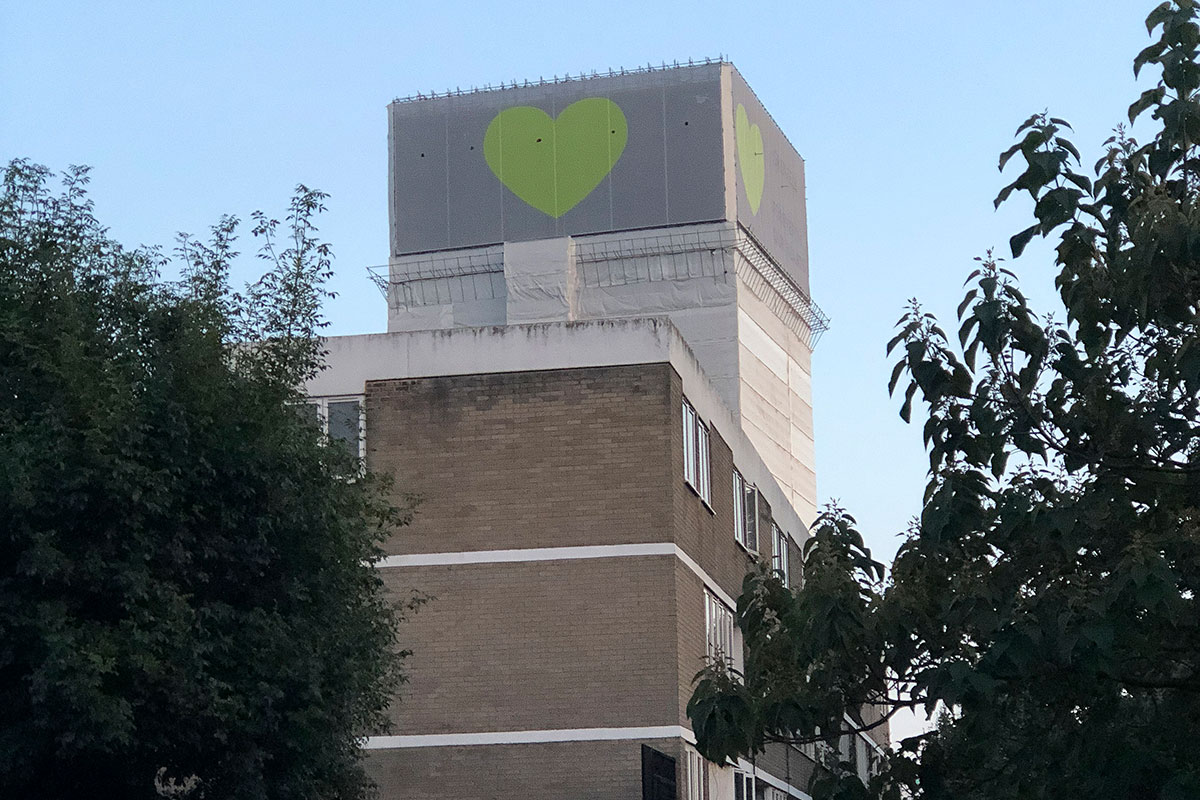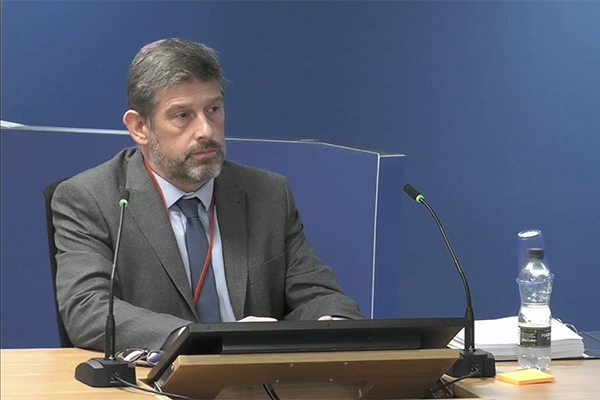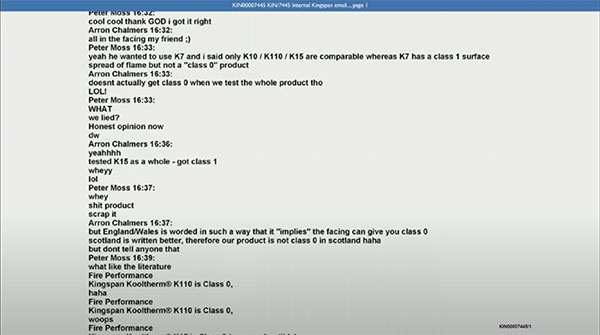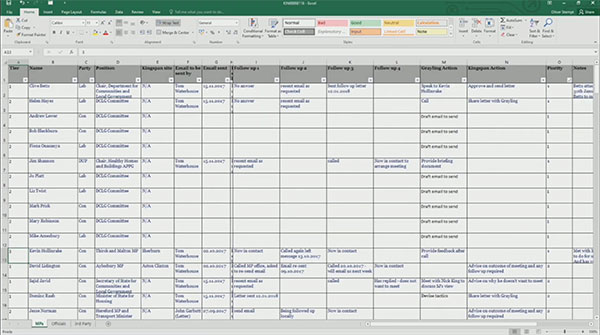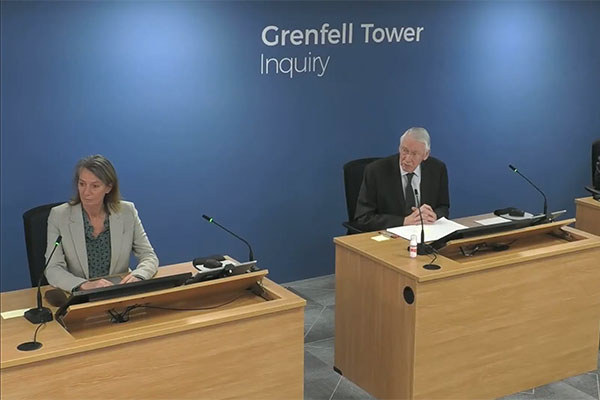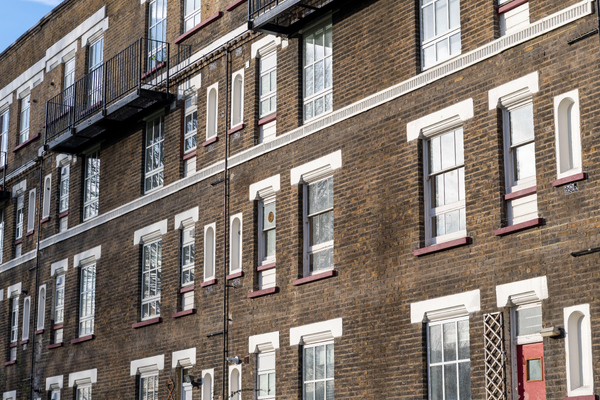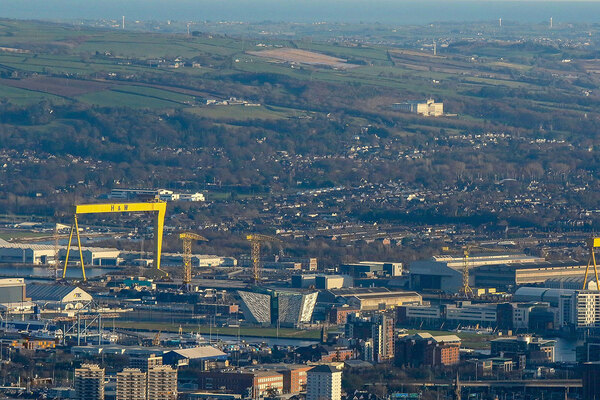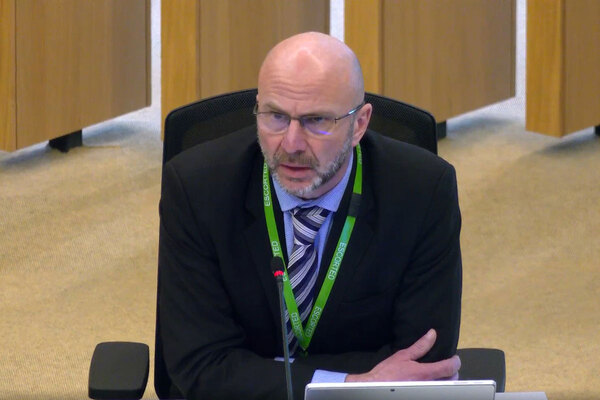You are viewing 1 of your 1 free articles
Grenfell Tower Inquiry diary week 22: ‘All we do is lie in here’
In the third week of evidence from insulation giant Kingspan, the inquiry continued to uncover shocking details about the firm’s behaviour both before and after the Grenfell Tower fire. Lucie Heath reports
This week the inquiry heard evidence mostly from Adrian Pargeter, director of technical, marketing and internal affairs at Kingspan, which produced the Kooltherm K15 insulation found on parts of Grenfell Tower.
It was a shorter week than normal after hearings were put on hold on Wednesday afternoon when a member of the inquiry team tested positive for COVID-19. But there were still a number of shocking revelations.
We also gained more insight into how widely some of the testing issues we have already learned about during the inquiry were known about at Kingspan.
“It took four years between you first being told of the problem in 2016… to decide to withdraw that test. Do you accept that that is an extraordinarily long time?”
We already know that in October this year, Kingspan wrote to the Building Research Establishment (BRE) to withdraw tests that it had carried out on K15.
This letter revealed that Kingspan had been relying heavily on two fire tests, carried out in 2005 and 2014, to market K15, despite the fact neither test was carried out on the product actually being sold to the market.
This week we got to hear directly from the man who signed the letter to the BRE about exactly what was known within Kingspan prior to October 2020.
Mr Pargeter (above) told the inquiry he first learned that the 2005 tests had been carried out on an “old technology” version of K15 (which Kingspan stopped selling in 2006) four years ago, in late 2016.
He said he was not concerned about the information at the time because his colleague Gwyn Davies had told him “that the performance in fire would not have been any different”.
Mr Pargeter said that Mr Davies had no fire safety qualifications that he was aware of.
Despite being aware that the 2005 test had been carried out on a different product, Mr Pargeter did not include this information in his first witness statement to the inquiry in 2018.
“I think we were doing our investigations and we needed to be sure… we thought it could have been old tech and new tech. We needed to be sure exactly what it was,” he said as the explanation for this.
As for the 2014 test, Mr Pargeter said he had always been aware that a test had been carried out at that time on a research and development product, but that he had not realised this test was being used to market K15 until it was pointed out to him by Kingspan’s lawyers in preparation for the inquiry.
“If that was true, then you must accept that you had radically failed to a fundamental level in your obligations of safety in the role you held,” said Richard Millett, counsel to the inquiry, when questioning Mr Pargeter on his knowledge of the 2014 test.
“I certainly regret the fact that I missed that, but I don’t think it was a fundamental effect on fire safety error,” Mr Pargeter replied.
The inquiry also learned that Kingspan removed the 2005 test from its website in March 2019, more than a year and a half before taking the decision to finally withdraw the test. Mr Pargeter said the decision to remove the test from the website was taken by “the team involved in the inquiry”.
Following this, Kingspan took the decision to test the K15 product actually being sold to the market. The firm received a report confirming that K15 had passed this test in February 2020.
When asked what changed in the four years before finding out about the 2005 test and finally withdrawing the test in October 2020, Mr Pargeter said: “I think we were looking at it under a different light, obviously much more focus on it, and I think just the opinion then was it would be prudent to withdraw it at this stage.”
Mr Millett asked: “The only difference was the degree of scrutiny being applied to the question by the inquiry?”
“Potentially, yes,” Mr Pargeter replied.
“Your approach to this issue is not only dishonest but displayed a reckless disregard for human life”
In addition to the well-documented issues surrounding Kingspan’s 2005 and 2014 K15 tests, this week the inquiry also uncovered issues relating to the testing used by the insulation firm to prove that the product had achieved a ‘Class 0’ rating.
While Class 0 is not a relevant standard for the use of insulation on high rises, many in the construction industry misunderstood this and took it to mean that the product was safe to use on buildings taller than 18m. The claim that K15 was rated Class 0 often featured prominently in Kingspan’s marketing for the product.
But this week the inquiry learned that as of 2016, Kingspan had only ever tested the foil facer, rather than the whole K15 insulation product, when determining whether it could achieve Class 0.
The reason for this was a loophole in Approved Document B (ADB) of the building regulations of England and Wales, which said a product could be referred to as Class 0 if “the surface of a composite product” achieved a certain performance under testing. Kingpsan relied heavily on this interpretation of the building regulations to make its Class 0 claim.
The following exchange between Mr Millett and Mr Pargeter on Tuesday saw the latter stick to the company’s line that this is a fair way to interpret the building regulations.
Mr Millett asked: “So on your technical reading of ADB you could staple a foil facer to dynamite and put it on a building of above 18 metres and call it Class 0?”
Mr Parteger replied: “No, because you wouldn’t have a classification of Class 0 applied to a stick of dynamite. It wouldn’t be a requirement.”
Mr Millett continued: “Actually, what Kingspan were doing with your adoption of the view was pursuing a technical interpretation of ADB but not a… commonsense interpretation of ADB.”
Mr Parteger responded: “I think it’s a technical interpretation, but it’s on an insulation product, so it’s a commonsense approach as well.”
Following this, the inquiry was shown an email chain from 2016 in which several members of Kingspan’s marketing and technical team, including Mr Pargeter, debated whether they should refer to K15 as Class 0.
Two members of Kingspan’s technical team had been told by a fire engineer that they should be testing the entire product, however one employee said that the engineer had told him: “We are okay claiming class 0 from foil as it can be interpreted like that. Hes [sic] just got to take the fire engineer perspective and cover himself.”
The second employee replied: “Yeah, does seem a bit of a cheat though doesn’t it claiming Class 0 for just a facer test, when as you said its [sic] meant to be product as placed on the market.”
Shortly after this exchange, Kingspan carried out testing of the entire K15 composite product, and it failed to achieve Class 0.
Following this, Mr Pargeter told the inquiry he decided to continue marketing K15 as Class 0 in England and Wales, however Kingspan was forced to drop the phrase “low risk” from its marketing in Scotland because of differences in the fire regulations there.
The inquiry was then shown a shocking text message exchange between Arron Chalmers, technical project leader at Kingspan, and another employee, who joked about K15 being marketed as Class 0 despite it failing the test.
Examples of some of the texts are as follows:
“doesnt [sic] actually get class 0 when we test the whole product tho LOL!”
“WHAT we lied?”
“yeahhhh tested K15 as a whole – got class 1 [an inferior standard] wheyy lol”
"alls [sic] we do is lie in here"
Around that same time, Kingspan received an enquiry from a Scottish architect who was looking to confirm whether it was safe to install cavity barriers only every 20m on a building using K15, as K15 was rated Class 0.
Mr Chalmers flagged this query to Mr Pargeter in an email and said Kingspan could either “be honest” and inform the architect that cavity barriers will be needed every 10m or “blag it” and “ignore her direct question”.
There is no evidence that Kingspan ever informed the architect that K15 as a composite product had failed the Class 0 test.
“I’m bound to suggest to you, Mr Pargeter, that your approach to this issue is not only dishonest but displayed a reckless disregard for human life and safety,” said Mr Millett.
“No, I disagree,” replied Mr Pargeter.
“Did you not think it incumbent on you to ensure that you were not promoting the use of K15 with an ACM PE core?”
Also on Tuesday, the inquiry was shown a marketing brochure that Kingspan put together in 2015 as part of a campaign called ‘Routes to Compliance’. The point of the campaign was to educate the market on the various ways K15 could achieve compliance with the building regulations.
The document included a number of case studies of K15 being used with aluminium composite material (ACM) cladding with a polyethylene (PE) core, which is the same type of cladding used on Grenfell.
But the only study that had been carried out on K15 and ACM together had been on ACM with a fire-retardant core. Even then, this study relied on the K15 tests, which – as we have previously heard – were carried out on a different product to the one being sold to the market.
“Did you not think it incumbent on you as [head of marketing and technical] to ensure that you were not promoting the use of K15… with an ACM PE core?” Mr Millett (above) asked Mr Pargeter.
“No, it wouldn’t have occurred, not to me, I wasn’t aware of the differences in the ACM options,” said Mr Pargeter, adding that Kingspan was not “particularly au fait” with the difference between a PE and a fire-retardant core.
In addition to this marketing material, the inquiry was shown a letter sent by Kingspan to a contractor confirming that K15 could be installed at Spruce Court, a development in Salford using ACM with a PE core. The letter refers to a successful BS 8414 test, despite the fact that a BS 8414 test was never carried out on this system by Kingspan.
Mr Pargeter agreed that the letter was “misleading”.
“We are slowly educating the NHBC”
Another interesting piece of information touched on briefly by the inquiry on Tuesday came in the form of an internal Kingspan email sent by former employee Ivor Meredith.
“We are slowly educating the NHBC [National House Building Council] and worked with them and the BCA [Building Control Alliance] to produce BCA Technical Note 18,” the email said.
Technical Note 18 was a key piece of guidance released by the BCA in 2015. This note allowed those involved in a construction project to submit desktop studies of a particular system to building control if no fire test data existed for that system, and for these tests to be provided by a fire engineer rather than an accredited test house.
Following the fire at Grenfell, sector bodies have criticised the use of desktop studies.
When asked about this email during the inquiry this week, Mr Pargeter said he did “not recall” Kingspan “slowly educating” the NHBC or the BCA.
However, he did agree with Mr Millett that “both NHBC and Kingspan were keen to expand the routes to compliance”.
“This was a deliberate attempt to deceive Mr Betts and the select committee, wasn’t it?”
On Wednesday morning, the inquiry focused mainly on Kingspan’s actions after the Grenfell Tower fire, more specifically on its efforts to persuade the government against adopting a ban on combustible materials on high rises.
We learned that Kingspan hired a PR firm called Portland in the weeks after the fire. Together they created a “political engagement plan”, with the stated aim of getting Kingspan’s “message out to the people that matter”.
The plan had a list of key targets to reach out to, including then housing secretary Sajid Javid, Dame Judith Hackitt and members of the Housing, Communities and Local Government (HCLG) Select Committee.
“One of the key arguments that we need to win with political stakeholders is that combustible materials are no more dangerous that [sic] non-combustible materials when improperly installed,” one email from early 2018 read.
In another 2018 email titled “MHCLG Select Committee Lobbying”, one Kingspan employee said that Conservative MP and HCLG Committee member Kevin Hollinrake was “lukewarm” about Kingspan’s arguments and suggested setting up tests to demonstrate K15 performing similarly to a non-combustible insulation produced by Kingpsan’s competitor Rockwool.
Kingspan went on to set up two tests of non-combustible insulation in Ulster and Dubai. We saw several emails proving that on both occasions Kingspan designed the system being tested in a way that would ensure the Rockwool insulation performed as poorly as possible.
This included using “poor” cavity barriers and a cladding product that was not widely available in the UK.
“It looks from those parts of the description of what was proposed that this was… deliberately set up to fail,” said Mr Millett.
“I think that is the weakest option of a compliant system… I’m not sure whether that would be a typical build-up but certainly a potential build-up,” Mr Pargeter replied.
When questioned further by Sir Martin Moore-Bick, chair of the inquiry, Mr Pargeter admitted that Kingspan’s motivation for carrying out these tests was “not entirely altruistic”.
These test results were then sent to the HCLG Committee as part of a 96-page submission to Dame Judith’s Independent Review of Building Regulations and Fire Safety. At no point in the document did Kingspan mention that the tests had been designed to achieve the worst performance possible.
Kingspan also sent the test results to senior civil servant Brian Martin.
“We erred on the safe side and so the ACMs had their edges folded over to protect the core of the panels from fire,” John Garbutt, divisional marketing director at Kingspan, wrote in an accompanying email.
During this exchange, we saw Mr Martin ask Kingspan if it had some leftover testing material that it could share with the government to use in its own tests.
“We do. But it might cost a meeting with a minister,” Mr Garbutt replied.
When asked whether Kingspan had met with a minister following this email, Mr Pargeter said he could “not recall”.
Following questioning, Mr Pargeter said he may have met a minister at a dinner he attended at the Houses of Parliament in January 2018.
Mr Millett referred to this as “the Kevin Hollinrake dinner”.
“The impression one gets from this email run is that Kingspan is… cosying up to a senior civil servant in the MHCLG with a view to using him as a stepping stone to access power at the very highest level,” Mr Millett said.
Mr Parteger replied: “I think that would be an overstatement… I think John was just being a bit sarcastic.”
Update on 25.3.2021 at 4.30pm:
Following Kingspan disputing some of the questions put to Mr Pargeter he returned in March 2021 to give additional evidence. You can read a report of that session here.
“We’re going to have to close the hearings for the time being”
On Wednesday afternoon, the inquiry began hearing from Richard Burnley, former managing director at Kingspan.
Mr Burnley was giving his perspective on some of the evidence that we have already heard, when the hearing was interrupted by Sir Martin, who informed the attendees that a member of the inquiry team had tested positive for COVID-19.
“We’ve considered very carefully whether there is any way in which we could carry on on some revised basis, but I'm afraid we’ve come to the conclusion that that simply is not possible. So, regrettably at this point we’re going to have to close the hearings for the time being,” he said.
The inquiry has now been postponed until 11 January, when we will resume hearing from Mr Burnley.
Grenfell Tower Inquiry phase two: weekly diaries
Module one: the refurbishment
Week one: A vivid picture of a broken industry
After a week of damning revelations at the opening of phase two of the Grenfell Tower Inquiry, Peter Apps recaps the key points
Click here to read the full story
Week two: What is the significance of the immunity application?
Sir Martin Moore-Bick has written to the attorney general requesting protection for those set to give evidence at the Grenfell Tower Inquiry. Peter Apps explains what the move means
Click here to read the full story
Week three: Architects of misfortune
This week saw the lead architects for the Grenfell Tower refurbishment give evidence to the inquiry. Peter Apps runs through the key points
Click here to read the full story
Week four: ‘I didn’t have any perception that it was the monster it’s become’
The architects continued to give evidence this week, outlining a lack of understanding of the fire risk posed by the cladding materials and its design. Nathaniel Barker reports
Click here to read the full story
Week five: ‘No adverse effect in relation to external fire spread’
As the Grenfell Tower Inquiry returns from its long absence, Peter Apps recaps the key points from a week of important evidence from the fire consultants to the refurbishment
Click here to read the full story
Week six: ‘I can’t recall any instance where I discussed the materials with building control’
Nathaniel Barker summarises what we learned from fire engineers Exova, architects Studio E and the early evidence from contractor Rydon
Click here to read the full story
Week seven: ‘I do not think I have ever worked with a contractor operating with this level of nonchalance’
Two key witnesses from contractor Rydon gave evidence this week. Peter Apps recaps some of the key points from a revealing week of evidence
Click here to read the full story
Week eight: ‘It haunts me that it wasn't challenged’
Four witnesses from contractor Rydon gave evidence this week. Lucie Heath recaps what we learned on the last week of evidence before the inquiry breaks for five weeks
Click here to read the full story
Week nine: ‘All I can say is you will be taken out for a very nice meal very soon’
This week the inquiry heard evidence from witnesses at Harley Facades, the sub-contractor responsible for Grenfell Tower’s cladding. Peter Apps recaps the key points
Click here to read the full story
Week 10: ‘As we all know, ACM will be gone rather quickly in a fire!’
As the Grenfell Tower Inquiry entered its 10th week, Jack Simpson recaps the key points from a week of important evidence from the refurbishment’s cladding contractor
Click here to read the full story
Week 11: ‘Did you get the impression Grenfell Tower was a guinea pig for this insulation?’
With witnesses from the cladding subcontractor, the firm which cut the deadly panels to shape and the clerk of works which inspected the job giving evidence this was week full of revelations. Peter Apps recaps the key points
Click here to read the full story
Week 12: ‘Would you accept that was a serious failing on your part?’
With the surveyor who inspected Grenfell Tower for compliance giving evidence, this was a crucial week from the inquiry. Dominic Brady and Peter Apps report
Click here to read the full story
Week 13: ‘Value for money is to be regarded as the key driver for this project’
With consultants to Kensington & Chelsea Tenant Management Organisation (KCTMO) giving evidence, attention at the Grenfell Tower Inquiry turned for this first time to the actions of the TMO and the council. Peter Apps reports
Click here to read the full story
Week 14: ‘Did it not occur to you at this point that your budget was simply too low?’
This week, for the first time in phase two, the inquiry heard from Kensington & Chelsea Tenant Management Organisation, the landlord that oversaw the fatal refurbishment of Grenfell Tower. Lucie Heath reports
Click here to read the full story
Week 15: ‘Have you ever informed the police that you destroyed documents relevant to their investigation?’
Witnesses from the Kensington and Chelsea Tenant Management Organisation (KCTMO) gave evidence for a second week, which began with a shocking revelation about withheld and destroyed evidence. Peter Apps recaps
Click here to read the full story
Week 16: ‘I conclude this was very serious evidence of professional negligence’
This week saw members of Kensington & Chelsea Tenant Management Organisation finish giving evidence, before the inquiry’s expert witnesses took the stand to make some highly critical assessments of the work they had seen before and during the refurbishment of Grenfell Tower. Jack Simpson recaps
Click here to read the full story
Grenfell Tower: a timeline of the refurbishment
Following the conclusion of module one of the Grenfell Inquiry’s second phase, Peter Apps presents a timeline of the key moments during the fatal refurbishment of the west London tower block
Click here to read the full story
Module two: the cladding products
Week 17: ‘It’s hard to make a note about this because we are not clean’
The start of the second module of the Grenfell Tower Inquiry phase two came with some huge revelations about the companies that sold the products used in the cladding system. Peter Apps reports
Click here to read the full story
Week 18: ‘It was just reckless optimism wasn't it?’
As the inquiry began cross-examining witnesses for the second module of its phase two work, the picture surrounding just how Grenfell Tower ended up wrapped in such dangerous materials became a little clearer. Nathaniel Barker was keeping an eye on proceedings
Click here to read the full story
Week 19: ‘And that was intentional, deliberate, dishonest?’
The Grenfell Tower Inquiry this week heard the shocking story of how the insulation manufacturer “manipulated” official testing and marketed its product “dishonestly”. Peter Apps tells the story
Click here to read the full story
Week 20: ‘We were outed by a consultant who we then had to fabricate a story to’
This week the inquiry investigated the actions of Kingspan – the manufacturer of one of the insulation products used in the tower’s cladding system. Dominic Brady reports
Click here to read the full story
Week 21: ‘It’s there in black and white isn't it? We see a complete absence of any consideration of life safety’
The story of insulation giant Kingspan’s testing and marketing of its combustible insulation for high rises was unpacked in minute detail this week. Peter Apps reports
Click here to read the full story
Week 22: ‘All we do is lie in here’
In the third week of evidence from insulation giant Kingspan, the inquiry continued to uncover shocking details about the firm’s behaviour both before and after the Grenfell Tower fire. Lucie Heath reports
Click here to read the full story
Week 23: ‘That would have come as an earthquake to you at the time, would it not?’
This week the inquiry took its deepest dive yet into the inner workings of the cladding manufacturer whose product has been blamed for the terrible spread of fire up Grenfell Tower. Nathaniel Barker reports
Click here to read the full story
Week 24: ‘Do you accept that Test 5B was Arconic's deadly secret’
The president of the firm that made and sold the cladding panels installed on Grenfell Tower was asked to account for the apparent concealment of “disastrous” fire tests on the product this week. Peter Apps reports
Click here to read the full story
Week 25: ‘This is quite an incredible list of omissions and missed instances, isn’t it?’
This week the Grenfell Tower Inquiry heard its first witnesses from the Building Research Establishment (BRE) - the testing house which carried out key fire tests on the Kingspan and Celotex insulation products which were later used on Grenfell Tower. Peter Apps reports.
Click here to read the full story
Week 26: 'You were taking an enormous risk, weren't you?'
Week 26 at the Grenfell Tower Inquiry was a key moment in understanding how dangerous products used on the tower came to be accepted by industry professionals. Dominic Brady reports
Click here to read the full story
Week 27: ‘What will happen if one building made out [of] PE core is in fire and will kill 60 to 70 persons?’
The most explosive evidence this week at the Grenfell Tower Inquiry came from those who did not attend, as the evidence which would have been presented to Arconic witnesses was displayed in their absence. Peter Apps reports
Click here to read the full story
Week 28: ‘This is a serious safety matter’
This week the Grenfell Tower Inquiry zeroed in on the British Board of Agrément, the body that produced “misleading” certificates which inspired trust in both the cladding and insulation used on the tower. Lucie Heath reports
Click here to read the full story
Week 29: ‘Is it true that Kingspan’s position… was to do its best to ensure that science was secretly perverted for financial gain?’
The final week in this section of the Grenfell Tower Inquiry primarily examined the attempts by insulation manufacturer Kingspan to lobby government after the fire. Peter Apps reports
Click here to read the full story
How the products used in Grenfell Tower's cladding system were tested and sold
As the section of the Grenfell Tower Inquiry examining how the products used in the cladding system were tested, marketed and sold comes to a close, Peter Apps summarises what we have learned about each of the products included in the system
Click here to read the full story
Module Three: the management of the tower
Week 30: ‘There is certainly a high probability that in the event of a fire the whole building can become an inferno’
The focus of the inquiry shifted this week to the actions of the social housing providers responsible for maintaining Grenfell Tower. Pete Apps recaps what we learned
Click here to read the full story
Week 31: ‘If we cannot get out people will die’
This week saw the former residents of Grenfell Tower enter the witness box to tell of their experiences attempting to raise complaints with the council and its managing agent. Pete Apps reports
Click here to read the full story
Week 32: ‘Let's hope our luck holds and there isn't a fire’
This week saw the return of the landlord of Grenfell Tower, Kensington and Chelsea Tenant Management Organisation (KCTMO), as senior staff members attempted to explain how vital fire safety protections at the block were allowed to fall into disrepair. Lucie Heath reports
Click here to read the full story
Week 33: ‘Isn't that a serious gap in the scope of a policy meant to safeguard vulnerable people?’
A slightly disjointed week at the Grenfell Tower inquiry saw further evidence from staff at building manager Kensington and Chelsea Tenant Management Organisation (KCTMO) interspersed with the views of a cladding expert. Peter Apps reports
Click here to read the full story
Week 34: ‘Some members of the community are doing their best to spread false information’
Jack Simpson covers all the major revelations from the past week of evidence at the Grenfell Inquiry, including evidence from Laura Johnson, director of housing at the Royal Borough of Kensington and Chelsea.
Click here to read the full story
Week 35: ‘I really didn’t like the champagne’
This week the Grenfell Tower Inquiry saw council witnesses, including former deputy leader Rock Feilding-Mellen and leader Nicholas Paget-Brown, questioned about their role in the story for the first time. Peter Apps reports
Click here to read the full story
Week 36: ‘Is that not a very incurious approach for a fire risk assessor?’
This week the Grenfell Tower Inquiry scrutinised the work of Carl Stokes, the man hired to carry out fire risk assessments for the block. Nathaniel Barker reports
Click here to read the full story
Week 37: ‘In giving that advice, weren’t you acting beyond your knowledge and expertise?’
A curtailed week at the Grenfell Tower Inquiry saw fire risk assessor Carl Stokes grilled over advice he gave regarding the tower’s cladding. Peter Apps reports
Click here to read the full story
Week 38: ‘Well it’s a bit more than that, isn’t it. He’s suggesting that you tell the LFB a lie’
The inquiry heard the mammoth cross-examination of KCTMO’s health and safety manager Janice Wray this week. Peter Apps reports
Click here to read the full story
Week 39: ‘What you said there was a grotesque understatement’
This week the inquiry continued to hear from former employees of Kensington and Chelsea Tenant Management Organisation, as well as two employees from the London Fire Brigade. Lucie Heath reports
Click here to read the full story
Week 40: ‘An exercise in concealment and half-truth’
Former KCTMO chief executive Robert Black gave his evidence to the inquiry this week and was asked to account for the various failures described over the previous six weeks. Peter Apps and Nathaniel Barker report.
Click here to read the full story
Week 41: ‘We should do nothing. This is not the sort of website we should be responding to’
This week saw the return of Robert Black, chief executive of Kensington and Chelsea Tenant Management Organisation (KCTMO), before the inquiry turned its attention to the defective smoke control system in the tower. Dominic Brady reports
Click here to read the full story
Week 42:‘They would leak as much as they leaked. They were what they were’
The Grenfell Tower Inquiry continued its in-depth investigation of the tower’s non-compliant smoke control system this week, with evidence from the various contractors involved in delivering it. Pete Apps reports
Click here to read the full story
Week 43:‘Contractors at the time were not generally aware of the importance of leaving holes unsealed’
This week the inquiry focused on two of the more overlooked areas of the Grenfell Tower fire, with evidence focusing on the gas pipelines and lifts within the west London block. It was a packed week, with five witnesses giving evidence. Jack Simpson reports
Click here to read the full story
Week 44:‘I've never seen a fully compliant firefighting lift in any local authority building, to this day actually’
This week the inquiry turn the focus onto the building’s defective lifts, with evidence from an expert, contractors who worked on them and a former engineer at KCTMO. Pete Apps reports.
Click here to read the full story
Week 45: ‘Don’t you find all this rather a surprising debate, given that the Equality Act was passed in 2010?’
The inquiry heard from expert witness Colin Todd this week, who gave his views about the work of risk assessor Carl Stokes as well as answered questions about his own guidance. Peter Apps and Nathaniel Barker report
Click here to read the full story
Week 46: ‘I think I've been very, very clear that is completely wrong’
This week the inquiry heard further expert evidence about fire risk assessor Carl Stokes’ actions, as the section of its work covering the management and maintenance of the tower concluded. Peter Apps reports
Click here to read the full story
Six key failures in the way Grenfell Tower was managed before the fire
Peter Apps recaps some of what we have learned about the actions of the Royal Borough of Kensington and Chelsea (RBKC) and Kensington and Chelsea Tenant Management Organisation (KCTMO) in the years before the fire.
Module one and two closing statements
Week 47: ‘An unedifying spectacle’
After a week of closing statements from the core participants involved in modules one and two, Lucie Heath recaps the key arguments of each group
Click here to read the full story
Module five: the fire brigade
Week 48: ‘They knew, and lives could and should have been saved’
The phase of the Grenfell Tower Inquiry examining the actions of the London Fire Brigade in the years before the fire kicked off this week with some major revelations. Peter Apps reports
Click here to read the full story
Week 49: ‘I'm not sure we've always taken every opportunity to learn as an organisation’
How the London Fire Brigade acted upon lessons from incidents in the years before the Grenfell Tower disaster came under the microscope this week at the public inquiry. Nathaniel Barker reports
Click here to read the full story
Week 50: ‘There is a culture in LFB that is very conservative. I think there is great comfort in what is familiar’
This week the inquiry heard how the London Fire Brigade (LFB) elected not to issue warnings about dangerous cladding before Grenfell and a detailed examination of its policy for checking high risk buildings. Pete Apps reports.
Click here to read the full story
Week 51:‘We teach firefighters to expect building failure’
An unusually brief week of evidence at the Grenfell Tower Inquiry explored how a fire service neighbouring London was taking a different approach to tackling blazes in high rises. Nathaniel Barker reports
Click here to read the full story
Week 52: ‘I actually think that there is a measure of incompetence at all levels’
Expert evidence concluded the current section of the inquiry with some stinging criticism of the London Fire Brigade (LFB). Pete Apps and Grainne Cuffe report.
Click here to read the full story
Module six: fire services
Week 53: ‘They make for chilling reading and harrowing listening’
The inquiry’s investigation into central government began this week with lawyers setting out their view on how and why firefighting policies failed. Peter Apps and Lucie Heath report
Click here to read the full story
Week 54: ‘Our consideration of evacuation at this time was something of a blind spot’
The development of policy on ‘stay put’, both nationally and for London, occupied the attention of the inquiry this week. Peter Apps reports
Click here to read the full story
Week 55: ‘My review is pretty scathing!’
In a week that included the 200th day of evidence in phase two of the inquiry, attention turned to the London Fire Brigade’s control room. Lucie Heath reports
Click here to read the full story
Week 56: ‘Why didn't we thump the table harder’
This week, the control room at the London Fire Brigade was examined further – both before and after the fire. Pete Apps and Lucie Heath report
Click here to read the full story
Week 57: ‘It was worse than slow, it was sluggish’
Former London Fire Brigade (LFB) commissioner Dany Cotton was the star witness this week, as the inquiry continued to delve into the brigade’s knowledge and training before the Grenfell Tower fire. Jack Simpson, Grainne Cuffe and Pete Apps report
Click here to read the full story
Week 58: ‘I don't think we deserve to ask for trust until we demonstrate different outcomes’
A current and former commissioner of the London Fire Brigade (LFB) wrapped up the inquiry’s investigation into the actions of the brigade before the fire. Grainne Cuffe and Peter Apps report.
Module six: testing and government
One of the major scandals of our time: key revelations as the Grenfell Tower Inquiry turns to government
The government was accused of “covering up” the risks of dangerous cladding as its “unbridled passion for deregulation” left it a “junior party” to the construction industry as the latest phase of the public inquiry opened today. Peter Apps summarises some of the main points
Click here to read the full story
Week 59: ‘Recent tests have apparently shown it continued to burn for 20 minutes after the flame was taken away’
After shocking opening statements, the Grenfell Tower Inquiry turned its attention to the work of Local Authority Building Control. Pete Apps reports
Click here to read the full story
Week 60: ‘You could have an exact repeat of the Dubai fire in any number of buildings in London’
The Grenfell Tower Inquiry turned its attention to the work of the National House Building Council this week, with shocking revelations about the extent of the warnings issued to central government before the fire. Peter Apps reports
Click here to read the full story
Week 61: ‘Mistakes are meant for learning, not repeating’
In the first hearings of the new year, the Grenfell Tower Inquiry heard closing statements from the firefighting section of phase two. Lucie Heath reports
Click here to read the full story
Week 62: Did it ever occur to you that this act of collaboration was, in one sense, corrupting?
The Grenfell Tower Inquiry returned to the work of the National House Building Council (NHBC) this week, with a new shocking revelation about the government’s actions in the immediate aftermath of the fire. Peter Apps reports
Click here to read the full story
Week 63: ‘It came after the general move to deregulation. So more regulation was not welcome’
The government’s focus on deregulation before the Grenfell Tower fire was placed in the spotlight this week with a series of shocking revelations about its failure to amend fire safety guidance. Pete Apps and Grainne Cuffe report
Click here to read the full story
Week 64: ‘I didn’t think ACM would be suitable for use in any high-rise buildings. I don’t think anyone did’
This week, the Building Research Establishment’s Dr Sarah Colwell gave more than three days of evidence, with some huge revelations about what was known about the dangers of aluminium composite material years before the fire and the mass confusion over the government’s building regulations. Peter Apps and Jack Simpson report
Click here to read the full story
Week 65: ‘Unless the government does something now about ACM panels, people will die’
Further evidence from the Building Research Establishment and the first government witnesses added new depth to our understanding of how warnings were missed before the Grenfell Tower fire. Peter Apps reports
Click here to read the full story
Week 66: ‘Was there a cover-up?’
The latest evidence from the Grenfell Tower Inquiry tracked the government’s failure to act on fire safety warnings right up until the months before the fire. Peter Apps and Grainne Cuffe report
Click here to read the full story
Week 67: ‘When exposed to a fire, the aluminium melts away and exposes the polyethylene. Whoosh!’
This week the inquiry heard disturbing new evidence about the failure of senior government officials to act on warnings about dangerous cladding in the years before the Grenfell Tower fire. Peter Apps reports
Click here to read the full story
Week 68: ‘Can we agree that was a pretty dangerous thing to have, all this falling on one man’s shoulders?’
Three senior civil servants gave evidence this week, including the official who had responsibility for building regulations guidance on fire safety in the years before Grenfell. Peter Apps, Lucie Heath, Stephen Delahunty and Grainne Cuffe report
Click here to read the full story
Week 69: ‘It was just unthinkable. You had the makings here of a crisis you could not comprehend’
This week, civil servant Brian Martin gave his long-awaited evidence to the Grenfell Tower Inquiry. Peter Apps reports
Click here to read the full story
Week 70: ‘Show me the bodies’
An important week at the Grenfell Tower Inquiry saw a dramatic conclusion to the mammoth cross-examination of civil servant Brian Martin, as well as the first politicians. Peter Apps and Lucie Heath report
Click here to read the full story
Week 71: ‘I have changed my schedule to fit this in. I do have an extremely busy day meeting people’
Three politicians who were responsible for building regulations before Grenfell appeared before the inquiry this week, including the former communities secretary Eric Pickles, who responded to the coroner’s letter following the Lakanal House fire. Peter Apps and Lucie Heath report
Click here to read the full story
Module Four: aftermath
Week 72: 'The system isn't broken. It was built this way'
This week the inquiry turned to the shocking story of the lack of support for bereaved and survivors in the immediate aftermath of the Grenfell Tower fire. Peter Apps, Lucie Heath, Grainne Cuffe and Jack Simpson report
Click here to read the full story
Week 73: ‘Most people would regard that as hopeless’
This week, the Grenfell Tower Inquiry heard about the Royal Borough of Kensington and Chelsea’s chaotic response in the immediate aftermath of the blaze, from the staff responsible for it. Pete Apps, Stephen Delahunty and Grainne Cuffe report
Click here to read the full story
Week 74: ‘Do you agree that RBKC was ill-prepared and incapable to meet its duties’
This week, Nicholas Holgate, former chief executive of the Royal Borough of Kensington and Chelsea, was grilled on his failure to hand over control of the aftermath of the fire, despite the borough’s lack of capacity. Peter Apps reports
Click here to read the full story
Week 75: ‘It still shocks me to the core that that’s how we treat our citizens in this country’
This week the inquiry heard witnesses from the housing management body discuss their role in the aftermath of the Grenfell Tower fire, followed by a range of witnesses from other organisations which supported the response. Peter Apps and Grainne Cuffe report
Click here to read the full story
Week 76: ‘I fear this will become our New Orleans’
This week the inquiry heard from central government figures and members of the London-wide emergency response arrangements. Peter Apps and Grainne Cuffe report
Click here to read the full story
Week 77: ‘The planning wasn’t done and there was nothing for us to be drawing on’
The Grenfell Tower Inquiry’s examination of the aftermath of the fire concluded with witnesses from central government. Peter Apps reports
Click here to read the full story
Module seven: expert evidence and closing statements
Week 78: ‘The abandonment of the ‘stay put’ strategy for high-rise residential buildings is essential’
This week the Grenfell Tower Inquiry heard a range of expert witnesses discuss their reports. Peter Apps and Grainne Cuffe report
Click here to read the full story
Week 79: ‘You could argue the system was created to enable people to circumvent the rules’
The Grenfell Tower Inquiry continued to hear expert evidence this week, with two senior figures in the world of fire safety academia criticising the government’s approach before and after the blaze. Peter Apps and Grainne Cuffe report
Click here to read the full story
Week 80: ‘The evidence points to wilful blindness and complacency towards safety’
As the inquiry moves into its final stages, lawyers for the key players gave statements about the evidence surrounding central government. Peter Apps reports
Click here to read the full story
Week 81: ‘This is Islamophobia. It’s racism. It is the elephant staring back at us in the room’
This week, closing statements covering the aftermath of the fire delivered a shocking new revelation and an expert toxicologist gave his views on the causes of the deaths. Peter Apps reports
Click here to read the full story
Module eight: further evidence relating to the deceased
Week 82: ‘Their chance to hear about the circumstances in which their loved ones died is the culmination of five years of waiting’
The Grenfell Tower Inquiry moved into its final module this week, with evidence relating to the circumstances in which the victims died. Peter Apps reports
Click here to read the full story
Week 83: ‘They died together as they lived: caring for one another’
A second week of evidence relating to the circumstances in which the victims of the fire died delivered more heartbreaking stories about their final moments. Peter Apps recaps
Click here to read the full story
Week 84: ‘Every decision affects someone who is an adored child, a beloved sister, a respected uncle, a needed mother’
The final week of oral evidence for the Grenfell Tower Inquiry’s second phase contained more heartbreaking evidence about the deaths in the tower. Peter Apps reports
Click here to read the full story
Closing statements
Week 85: ‘The merry-go-round turns still, the notes of its melody clearly audible in the last few days’
The Grenfell Tower Inquiry returned this week for closing statements from lawyers representing the bereaved and survivors and the various parties under scrutiny for the fire. Pete Apps reports.
Sign up for our weekly Grenfell Inquiry newsletter
Each week we send out a newsletter rounding up the key news from the Grenfell Inquiry, along with the headlines from the week
Already have an account? Click here to manage your newsletters


